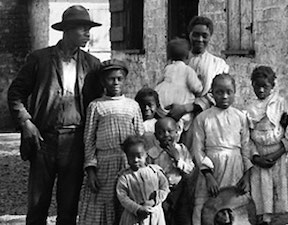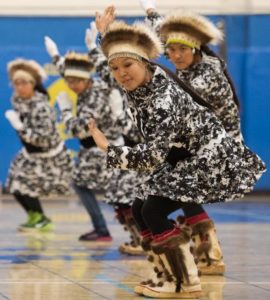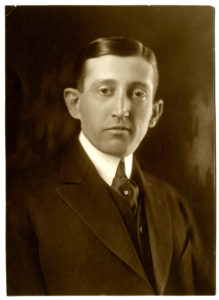Funds for Collections on Black Champions, Yu’Pik Life, and Censorship
In the slow march towards greater equity in American citizenship, sport has played a curious but undeniable role.

Among the interviews that Washington University will preserve is one with Mack Robinson, a track-and-field Olympian at the 1936 Munich games. Image: Washington University
Sports spectatorship, precisely because it fits Marx’s characterization of religion – as an opiate for the masses – as snugly as a shortstop’s favorite mitt, has shaped views of racial and ethnic groups’ capability and agency.
A key accomplishment of William Miles’s three-part Black Champions television documentary series in 1986 was to provide insights into how sports figures advanced the civil-rights movement by risking and incurring much public wrath for speaking out about injustices — such figures as baseballer Curt Flood, tennis player Arthur Ashe, basketballer Kareem Abdul-Jabbar, sprinter Wilma Rudolph, and Floyd Patterson, the youngest boxer to become world heavyweight champion and the first ever to regain the title after losing it.
With help from a National Historical Publications and Records Commission (NHPRC) grant, Washington University, in St. Louis, Missouri, will digitize and place online 32 filmed interviews with those and other sports figures that Miles (1931-2013) used for his Black Champions series.
Among the interviews is one with Mack Robinson (1914-2000, left), a track-and-field Olympian at the 1936 Munich Olympics and older brother of Baseball Hall of Fame member Jackie Robinson, whose integration into Major League Baseball was another subject of Miles’s series.
Upon his death in 2013, the New York Times called Miles (left) “part historical sleuth, part preservationist, part bard. His films, which combined archival footage, still photographs and fresh interviews, were triumphs of curiosity and persistence in unearthing lost material about forgotten subjects.”
The grant to Washington University is among 31 that the NHPRC made to archival units last month [June 2018] to preserve moving-image collections. The awards, announced by David S. Ferriero, Archivist of the United States, totaled over $4-million. Grants relating to moving-image collections went to Washington University’s William Miles collection, Bethel Broadcasting in Alaska, Indiana State Library, the Rock and Roll Hall of Fame in Cleveland, Ohio, and Rutgers University of New Jersey’s Papers of Thomas A. Edison project.
Moving-image collections are not the only, or even the major, focus of grants in the NHPRC’s program. In this round of awards, several institutions received help to continue their work on records relating to Presidents of the United States. Other grants will support key collections in American history. The University of North Carolina at Greensboro, for example, was given almost $295,000 to digitize 9,800 slave deeds and bills of sale from before the era of emancipation. The university will work on the project, People Not Property – Slave Deeds of North Carolina, part of its larger Digital Library on American Slavery, with the North Carolina State Archives, the Afro-American Genealogical Society, and registrars in 26 counties whose offices hold the records.
California State University at Fresno received a grant to digitize and place online 19,645 maps that show the changing geography and demographics of the state of California between the late 19th to late 20th centuries. Other grants will permit Indiana University-Purdue University to edit the Frederick Douglass Papers, the historical records of the 19th-century African American reformer and statesman. Ramapo College of New Jersey’s will continue its Jane Addams Papers Project, which will publish online the child-protection, workers-rights, and voting-rights activist’s papers from the period 1928-1921.
With its grant, Stanford University will continue its documentary edition of historical records relating to Martin Luther King Jr, including his role from 1962 to 1964 in planning and leading the campaign to end segregation in Birmingham, Alabama, and the seminal March of Washington for Jobs and Freedom.
The University of Iowa will continue work on Fame and Infamy: Walt Whitman’s Correspondence, 1888-1892, from the last four years of the American poet’s life. The letters will go into the online Walt Whitman Archive, a joint project with the University of Nebraska, Lincoln.
One of the largest awards ($250,000) went to Purdue University’s Archives Leadership Institute, an annual one-week event that provides training in archives leadership, advocacy, cultural competence, and technology. The project uses virtual-reality simulations and other cutting-edge technologies to train archivists from institutions across the country.
The few awards that do involve moving-image collections are just as varied and fascinating. With its grant of $100,000, Bethel Broadcasting of Bethel, Alaska will digitize and make available 1,000 video recordings drawn from Native-owned and -operated television station KYUK. The films document the Yup’ik and Cup’ik people of western Alaska, and depict dance performances, demonstrations of traditional crafts and technologies, and interviews with Elders who share traditional knowledge, values, and history in the Yup’ik language. Bethel Broadcasting will select films for preservation from what is believed to be the largest collection in the world of Yup’ik Eskimo-related video content.
In its award-funded project, Rutgers University, the largest state institution of higher education in the state of New Jersey, will work on material from the years 1888-1892. It will form part of Rutgers’ Papers of Thomas A. Edison, an edition of the historical records of the American inventor and entrepreneur. The project’s focuses include Edison’s development of new technologies for sound recordings and motion pictures.
The Rock and Roll Hall of Fame and Museum, in Cleveland, Ohio, will use its NHPRC grant to preserve 508 collections from the 1940s to the 2010s, some that include film.
Indiana State Library will not use its grant to preserve film, but rather its collection of records relating to the man who as much as any shaped American mass-market film — arguably, contributed mightily to its infantilization. The Library will digitize for online access its collection of the papers of William H. Hays, originator of the Hays Code that from thee 1920s restricted what could be included in American popular film. The records – some 47 cubic feet of them — date from 1914 to 1954, and include letters, speeches, scrapbooks, notebooks, and photographs ranging from his stint as state Republican chair in 1914 to his death in the 1950s. His son donated the papers in the 1980s.
From 1918 to 1921, Hays served as Republican Committee Chairman. In 1920 he was President Warren Harding’s campaign manager. Harding appointed Hays Postmaster General in 1921. But his most influential role came in 1922 when he began a 20-year tenure as President of the Motion Picture Producers and Distributors of America, Hollywood’s trade organization later known as the Motion Picture Association of America.
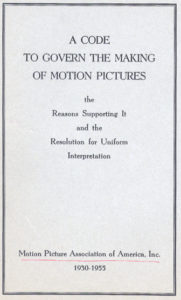 In that role, Hays, a Presbyterian elder, cited a purported crisis in morality in the industry to impose a voluntary but unavoidable Production Code of moral standards. The major Hollywood studios adhered to the Code from 1930 to 1968 when, due to court cases and opposition from directors and producers fed up with its imposed moralism, it was replaced by the MPAA film rating system.
In that role, Hays, a Presbyterian elder, cited a purported crisis in morality in the industry to impose a voluntary but unavoidable Production Code of moral standards. The major Hollywood studios adhered to the Code from 1930 to 1968 when, due to court cases and opposition from directors and producers fed up with its imposed moralism, it was replaced by the MPAA film rating system.
“Hays continues to be our most frequently-viewed collection, with scholars traveling from as far as the United Kingdom to view it,” according to the Indiana State Library project’s director, Bethany Fiechter. Part of cultural historians’ fascination with the code – other than that it would have been so dutifully adhered to – is the quizzical nature of its impositions. Those included bars on:
- “pointed profanity” including “profane and vulgar” use of such words as “God,” “Jesus,” “damn,” and “hell.”
- “licentious or suggestive nudity,” presumably even the most objectionable variety: brief.
- racial intermarriage.
- “any inference of sex perversion.”
And so much more!
“Ridicule of the clergy”…
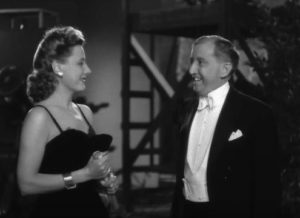 Fiechter says “providing digital access to this collection will undoubtedly change its usage levels. Researchers [who are] not able to visit the library […] will have unlimited access, leading to more research and discovery across multiple disciplines.”
Fiechter says “providing digital access to this collection will undoubtedly change its usage levels. Researchers [who are] not able to visit the library […] will have unlimited access, leading to more research and discovery across multiple disciplines.”
One curious item in the library’s collection was recently digitized and placed online: an eight-minute film featuring Hays. He banters on stage with actress and singer Irene Dunne at a gathering of the Indiana Society of Chicago in December 1941. Dunne sings “Back Home Again in Indiana,” the state from which both she and Hays haled. Hays apparently fancied himself as a thespian as well as confirmed moral muggins and myope — unreasonably so, judging by the results.
— Peter Monaghan
Previous Post: Tribesourcing the American Indian Film Gallery
Next Post: Calling All Believers


